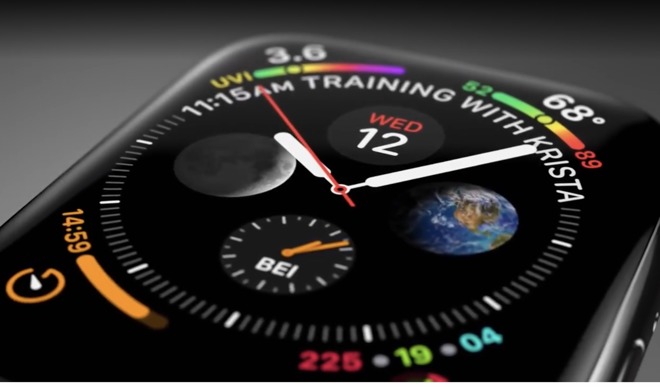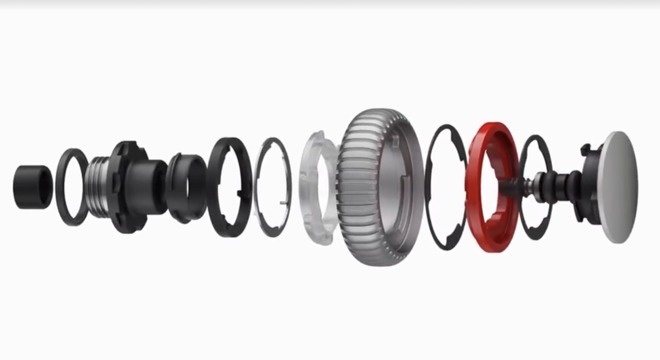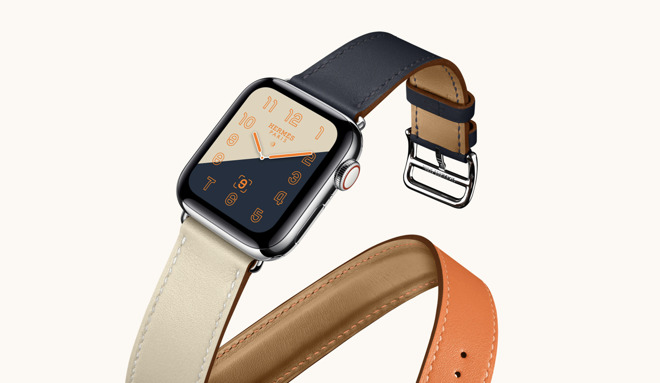Everything you need to know about Apple Watch Series 4
While you wait for your order to arrive, or are thinking about an upgrade, AppleInsider takes you through all of the new features packed into the overhauled Apple Watch Series 4.
Of all Apple's big announcements during their September "Gather Round" event, the Apple Watch was arguably the most exciting. The Apple Watch Series 4 marks the first physical redesign of the Apple Watch since it was first released.
The biggest feature is the new, nearly edge-to-edge display which garners more than 30 percent more usable real estate. Series 4 also has an updated casing that has more subtly rounded corners to match that of the display, and even manages to be slightly thinner.
If you have a lot of bands, don't worry, all existing watch bands will still fit. The 38mm bands fit the new 40mm size, and the older 42mm bands fit the 44mm.

To go with the larger display, Apple has re-worked many of the UI elements, including updating existing watch faces and including new ones. Developers are able to include new aspects to their complications, such as to accommodate the rounded corners or the larger space on the updated Infograph Modular watch face.

Apple signature Digital Crown now has an entirely new mechanism with haptic feedback given as it is rotated, allowing for even greater precision. It is both 30 percent smaller than the last generation, while using 21 percent more parts.
Within the updated Digital Crown is a sensor, which is also present on the rear of the watch. Touching both of these electronic sensors at the same time completes the circuit and makes another new feature possible -- an ECG. The screen will count you down and give you the results of your ECG and any potential abnormalities it detects.

The ECG is only one of a few new heart health monitoring features. Series 4 is also able to detect low heart rate as well as AFib. Unfortunately, some of these new features won't be available at launch, and instead will show up in a future software update.
Inside is a new second generation accelerometer with twice the dynamic range, with sampling happening eight times more frequently, and capable of measuring up to 32G. Thanks to that, Apple Watch Series 4 can now detect falls. In particular, it can detect straight down falls, slips, and trips.
If it detects a fall, an alert will appear on the Apple Watch. If you're ok, the alert can be dismissed. Otherwise, you can alert emergency services with the watch's SOS feature.
In a situation where you may be unresponsive, Apple Watch will alert emergency services and send your location to your emergency contact if it fails to detect any movement within 60 seconds.
Other improvements include 50 percent louder speakers, new and rearranged microphones, a seriously fast 64-bit S4 processor, better cellular reception, and Bluetooth 5.

Apple Watch Series 4 comes in several different finishes, and two different sizes. The larger screen is now 44mm whereas the smaller is 40mm (up from 42mm and 38mm before).
In aluminum, Series 4 comes in silver, space gray, and for the first time a gold color. The stainless comes in similar options, silver, gold, and space black -- all glossy options.
Orders have already opened and if you want to get one for yourself, they start off at $399 for the base GPS-only, aluminum, 40mm with sports band. The ceramic "Edition" model is gone, but for those looking for something more upscale, Apple has several Hermes options available that top out at $1,499. Check out AppleInsider's Apple Watch Price Guide for more deals.
Of all Apple's big announcements during their September "Gather Round" event, the Apple Watch was arguably the most exciting. The Apple Watch Series 4 marks the first physical redesign of the Apple Watch since it was first released.
Many updates -- inside and out

The biggest feature is the new, nearly edge-to-edge display which garners more than 30 percent more usable real estate. Series 4 also has an updated casing that has more subtly rounded corners to match that of the display, and even manages to be slightly thinner.
If you have a lot of bands, don't worry, all existing watch bands will still fit. The 38mm bands fit the new 40mm size, and the older 42mm bands fit the 44mm.

To go with the larger display, Apple has re-worked many of the UI elements, including updating existing watch faces and including new ones. Developers are able to include new aspects to their complications, such as to accommodate the rounded corners or the larger space on the updated Infograph Modular watch face.

Apple signature Digital Crown now has an entirely new mechanism with haptic feedback given as it is rotated, allowing for even greater precision. It is both 30 percent smaller than the last generation, while using 21 percent more parts.
Within the updated Digital Crown is a sensor, which is also present on the rear of the watch. Touching both of these electronic sensors at the same time completes the circuit and makes another new feature possible -- an ECG. The screen will count you down and give you the results of your ECG and any potential abnormalities it detects.

The ECG is only one of a few new heart health monitoring features. Series 4 is also able to detect low heart rate as well as AFib. Unfortunately, some of these new features won't be available at launch, and instead will show up in a future software update.
Inside is a new second generation accelerometer with twice the dynamic range, with sampling happening eight times more frequently, and capable of measuring up to 32G. Thanks to that, Apple Watch Series 4 can now detect falls. In particular, it can detect straight down falls, slips, and trips.
If it detects a fall, an alert will appear on the Apple Watch. If you're ok, the alert can be dismissed. Otherwise, you can alert emergency services with the watch's SOS feature.
In a situation where you may be unresponsive, Apple Watch will alert emergency services and send your location to your emergency contact if it fails to detect any movement within 60 seconds.
Other improvements include 50 percent louder speakers, new and rearranged microphones, a seriously fast 64-bit S4 processor, better cellular reception, and Bluetooth 5.
Where to buy

Apple Watch Series 4 comes in several different finishes, and two different sizes. The larger screen is now 44mm whereas the smaller is 40mm (up from 42mm and 38mm before).
In aluminum, Series 4 comes in silver, space gray, and for the first time a gold color. The stainless comes in similar options, silver, gold, and space black -- all glossy options.
Orders have already opened and if you want to get one for yourself, they start off at $399 for the base GPS-only, aluminum, 40mm with sports band. The ceramic "Edition" model is gone, but for those looking for something more upscale, Apple has several Hermes options available that top out at $1,499. Check out AppleInsider's Apple Watch Price Guide for more deals.


Comments
2) It looks like the Series 4 Watch stole the show this year.
I'll be very interested to see how they handle text size and wrapping with the rounded corners. This is how it's handled on the current watches:
If they merely scale this to the larger window, it will be cut off in the corners when scrolling. And note the default system size text -- will it be the same to accommodate more text in the new space, or will it be upscaled to be more legible in the larger display area?
I was going to buy my mom the Series 3 LTE when the price came down, until I saw the keynote with fall detection, and auto 911 if non responsive. This is brilliant and a major game changer, whatever the cost.
But yeah, AW4 is a big deal.
That said, I'm still surprised Apple did not maximize what's possible with current technology. Look at this graphic comparison below with the 42mm Huawei watch from 4 years ago, when the Apple Watch bezel was massive (brown). Note how the construction differs -- in the case of the Huawei (shape notwithstanding), the bezel is much thinner, and is hidden by the steel ring. While Apple narrowed the gap with the 44mm (orange), they still didn't go as far as the Huawei (rust), and due to Apple's glue-down construction would still have had a bezel. But they could have chosen to sink the display into the watch, and wrap the metal edges of the watch over what little bezel there was. This of course would have made the watch harder to repair any screen damage. So there's a trade off -- still Apple could have made the active display area larger than they did. And certainly they took their time doing it -- 4 generations after Huawei was doing it. The good news is that Apple can still maximize the active display area a little with this design in the future, though I'm not sure they can ever eliminate the bezel entirely as long as they glue down the crystal, even if it were otherwise possible.
As for the curved bezel, I really do wonder what they plan to do with presenting data. In the graphic below, note this text wrapping screen from the 42mm watch as it appears now, scaled up to the corners of the new 44mm, and then scaled up to the full active display area. It creates a bit of a quandary with those rounded corners really causing a problem with maximizing the space for text. If the text is to avoid wrapping pitfalls and inconsistent cropping, they really can't enlarge the text area much more than what they have now. I'll be very interested to see what they do with this. If text wrapping is constrained to a central area to avoid being cropped by the round corners, then I'm not sure what the point of having a larger display area is, or limiting it to a rectangular shape (then again, maybe that's the point).
EDIT: it appears as though Apple intends to crop scrolled text in the corners. I’m stunned that the time is clipped like that — maybe still a beta version?
Thongs Ike size and shape of an AW display are just minor obvious steps. Just like elimination of headphone jack etc. the only thing I hope is that it will be Apple surprising us with one more revaluation.
It goes through your iPhone via BT if you don't have a cellular model.